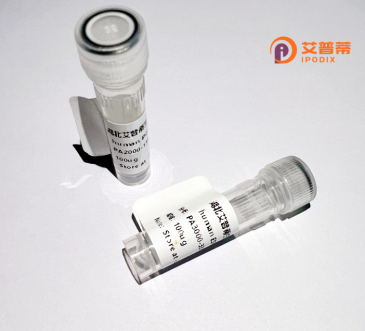
| 纯度 | >90%SDS-PAGE. |
| 种属 | Human |
| 靶点 | WDR73 |
| Uniprot No | Q6P4I2 |
| 内毒素 | < 0.01EU/μg |
| 表达宿主 | E.coli |
| 表达区间 | 1-378 aa |
| 活性数据 | MDPGDDWLVE SLRLYQDFYA FDLSGATRVL EWIDDKGVFV AGYESLKKNE ILHLKLPLRL SVKENKGLFP ERDFKVRHGG FSDRSIFDLK HVPHTRLLVT SGLPGCYLQV WQVAEDSDVI KAVSTIAVHE KEESLWPRVA VFSTLAPGVL HGARLRSLQV VDLESRKTTY TSDVSDSEEL SSLQVLDADT FAFCCASGRL GLVDTRQKWA PLENRSPGPG SGGERWCAEV GSWGQGPGPS IASLGSDGRL CLLDPRDLCH PVSSVQCPVS VPSPDPELLR VTWAPGLKNC LAISGFDGTV QVYDATSWDG TRSQDGTRSQ VEPLFTHRGH IFLDGNGMDP APLVTTHTWH PCRPRTLLSA TNDASLHVWD WVDLCAPR |
| 分子量 | 41.6 kDa |
| 蛋白标签 | His tag N-Terminus |
| 缓冲液 | PBS, pH7.4, containing 0.01% SKL, 1mM DTT, 5% Trehalose and Proclin300. |
| 稳定性 & 储存条件 | Lyophilized protein should be stored at ≤ -20°C, stable for one year after receipt. Reconstituted protein solution can be stored at 2-8°C for 2-7 days. Aliquots of reconstituted samples are stable at ≤ -20°C for 3 months. |
| 复溶 | Always centrifuge tubes before opening.Do not mix by vortex or pipetting. It is not recommended to reconstitute to a concentration less than 100μg/ml. Dissolve the lyophilized protein in distilled water. Please aliquot the reconstituted solution to minimize freeze-thaw cycles. |
以下是关于重组人WDR73蛋白的3篇参考文献,按研究内容分类概括:
1. **《WDR73 mutations impair protein interaction and cause Galloway-Mowat syndrome》**
*作者:Jinks et al. (2015)*
摘要:研究揭示WDR73基因突变通过破坏与伴侣蛋白的相互作用,导致Galloway-Mowat综合征(肾脑发育异常疾病),并发现WDR73在细胞周期调控中的作用。
2. **《Structural and functional analysis of WDR73 in microtubule dynamics》**
*作者:Chen et al. (2018)*
摘要:解析WDR73蛋白结构,表明其通过结合微管调控细胞分裂,重组WDR73蛋白实验显示其突变体导致细胞纺锤体缺陷和凋亡。
3. **《Recombinant WDR73 expression and interaction network in neuronal cells》**
*作者:Zhang et al. (2020)*
摘要:利用重组人WDR73蛋白筛选神经元中的互作蛋白,发现其参与mTOR信号通路,敲低WDR73导致神经元突触形成受损,提示其在神经发育中的关键功能。
---
**提示**:WDR73研究多聚焦于其与微管系统、细胞周期及神经系统疾病的关联。若需实验方法细节(如重组表达体系),建议补充筛选条件。
WDR73 (WD repeat-containing protein 73) is a member of the WD40 repeat protein family, characterized by conserved tandem repeats of ~40 amino acids that form β-propeller structures facilitating protein-protein interactions. It is ubiquitously expressed in human tissues and plays roles in cell cycle regulation, cytoskeletal organization, and intracellular trafficking. Studies suggest WDR73 interacts with components of the microtubule network, influencing mitotic spindle assembly and cytokinesis.
In 2014. WDR73 gained attention when mutations were linked to Galloway-Mowat syndrome (GAMOS), a rare autosomal recessive disorder causing neurological defects and early-onset nephrotic syndrome. Pathogenic variants in WDR73 disrupt its ability to bind microtubules, leading to cell cycle defects, apoptosis, and impaired podocyte function in kidneys. Its involvement in neural development is further supported by its localization in brain regions like the cerebellum and cerebral cortex.
Recombinant human WDR73 protein, produced via heterologous expression systems (e.g., E. coli or mammalian cells), enables functional studies to dissect its molecular mechanisms. Researchers use it to analyze interactions with partners like tubulin or kinesin-like proteins, study post-translational modifications, and model pathogenic mutations. Its structural complexity (multiple WD40 domains) and disease relevance make WDR73 a compelling target for biomedical research, particularly in understanding neurodevelopmental and renal pathologies. Recent work also explores its potential role in ciliopathies and cancer, though mechanistic insights remain incomplete.
×